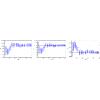当前位置:
X-MOL 学术
›
Phys. Rev. D
›
论文详情
Our official English website, www.x-mol.net, welcomes your
feedback! (Note: you will need to create a separate account there.)
Hints of a local matter underdensity or modified gravity in the low z Pantheon data
Physical Review D ( IF 4.6 ) Pub Date : 2020-07-10 , DOI: 10.1103/physrevd.102.023520 L. Kazantzidis , L. Perivolaropoulos
Physical Review D ( IF 4.6 ) Pub Date : 2020-07-10 , DOI: 10.1103/physrevd.102.023520 L. Kazantzidis , L. Perivolaropoulos

|
A redshift tomography of the Pantheon type Ia supernovae (SnIa) data focusing on the best fit value of the absolute magnitude $M$ and/or Hubble constant $H_0$ in the context of $\Lambda$CDM indicates a local variation ($z\lesssim 0.2$) at $2\sigma$ level, with respect to the best fit of the full dataset. If this variation is physical, it can be interpreted either as a locally higher value of $H_0$, corresponding to a local matter underdensity $\delta \rho_0/\rho_0 \simeq -0.10 \pm 0.04$ or as a time variation of Newton's constant which implies an evolving Chandrasekhar mass and thus an evolving absolute magnitude $M$ of SnIa. The local void scenario would predict an anisotropy in the best fit value of $H_0$ since it is unlikely that we are located at the center of a local spherical underdensity. Using a hemisphere comparison method we find an anisotropy level consistent with simulated isotropic datasets. We show however, that the anisotropic sky distribution of the Pantheon SnIa data induces a preferred range of directions even in simulated Pantheon data obtained in the context of isotropic $\Lambda$CDM. We thus construct a more isotropically distributed subset of the Pantheon SnIa and show that the preferred range of directions disappears. Using this subset we again find no evidence for anisotropy using either the hemisphere comparison method or the dipole fit method. In the context of the modified gravity scenario, we allow for an evolving normalized Newton's constant consistent with General Relativity (GR) at early and late times $\mu(z)=1+g_a z^2/(1+z)^2-g_a z^4/(1+z)^4$ and fit for $g_a$ assuming $L\sim G_{\rm{eff}}^b$. For $b=-3/2$ indicated by previous studies we find $g_a=-0.47 \pm 0.36$ which is more than $1.5\sigma$ away from the GR value of $g_a=0$. This weak hint for weaker gravity at low $z$ is consistent with similar evidence from growth and weak lensing data.
中文翻译:

低 z 万神殿数据中局部物质密度不足或重力改变的提示
万神殿 Ia 型超新星 (SnIa) 数据的红移断层扫描专注于 $\Lambda$CDM 背景下绝对星等 $M$ 和/或哈勃常数 $H_0$ 的最佳拟合值表明局部变化 ($z \lesssim 0.2$) 在 $2\sigma$ 级别,相对于完整数据集的最佳拟合。如果这种变化是物理变化,则可以将其解释为 $H_0$ 的局部较高值,对应于局部物质密度不足 $\delta \rho_0/\rho_0 \simeq -0.10 \pm 0.04$ 或牛顿的时间变化常数,这意味着不断发展的钱德拉塞卡质量,因此不断发展的 SnIa 绝对量级 $M$。局部空隙场景将预测 $H_0$ 的最佳拟合值中的各向异性,因为我们不太可能位于局部球形密度不足的中心。使用半球比较方法,我们找到了与模拟的各向同性数据集一致的各向异性水平。然而,我们表明,即使在各向同性 $\Lambda$CDM 背景下获得的模拟万神殿数据中,万神殿 SnIa 数据的各向异性天空分布也会引起首选的方向范围。因此,我们构建了万神殿 SnIa 的更各向同性分布的子集,并表明首选的方向范围消失了。使用这个子集,我们再次使用半球比较方法或偶极拟合方法没有发现各向异性的证据。在修改后的重力场景的背景下,我们允许在早期和晚期与广义相对论 (GR) 一致的演化归一化牛顿常数 $\mu(z)=1+g_a z^2/(1+z)^2 -g_a z^4/(1+z)^4$ 并适合 $g_a$ 假设 $L\sim G_{\rm{eff}}^b$。对于先前研究表明的 $b=-3/2$,我们发现 $g_a=-0.47 \pm 0.36$ 与 $g_a=0$ 的 GR 值相差超过 $1.5\sigma$。在低 $z$ 处重力减弱的这种微弱暗示与来自增长和疲弱透镜数据的类似证据一致。
更新日期:2020-07-10
中文翻译:

低 z 万神殿数据中局部物质密度不足或重力改变的提示
万神殿 Ia 型超新星 (SnIa) 数据的红移断层扫描专注于 $\Lambda$CDM 背景下绝对星等 $M$ 和/或哈勃常数 $H_0$ 的最佳拟合值表明局部变化 ($z \lesssim 0.2$) 在 $2\sigma$ 级别,相对于完整数据集的最佳拟合。如果这种变化是物理变化,则可以将其解释为 $H_0$ 的局部较高值,对应于局部物质密度不足 $\delta \rho_0/\rho_0 \simeq -0.10 \pm 0.04$ 或牛顿的时间变化常数,这意味着不断发展的钱德拉塞卡质量,因此不断发展的 SnIa 绝对量级 $M$。局部空隙场景将预测 $H_0$ 的最佳拟合值中的各向异性,因为我们不太可能位于局部球形密度不足的中心。使用半球比较方法,我们找到了与模拟的各向同性数据集一致的各向异性水平。然而,我们表明,即使在各向同性 $\Lambda$CDM 背景下获得的模拟万神殿数据中,万神殿 SnIa 数据的各向异性天空分布也会引起首选的方向范围。因此,我们构建了万神殿 SnIa 的更各向同性分布的子集,并表明首选的方向范围消失了。使用这个子集,我们再次使用半球比较方法或偶极拟合方法没有发现各向异性的证据。在修改后的重力场景的背景下,我们允许在早期和晚期与广义相对论 (GR) 一致的演化归一化牛顿常数 $\mu(z)=1+g_a z^2/(1+z)^2 -g_a z^4/(1+z)^4$ 并适合 $g_a$ 假设 $L\sim G_{\rm{eff}}^b$。对于先前研究表明的 $b=-3/2$,我们发现 $g_a=-0.47 \pm 0.36$ 与 $g_a=0$ 的 GR 值相差超过 $1.5\sigma$。在低 $z$ 处重力减弱的这种微弱暗示与来自增长和疲弱透镜数据的类似证据一致。











































 京公网安备 11010802027423号
京公网安备 11010802027423号